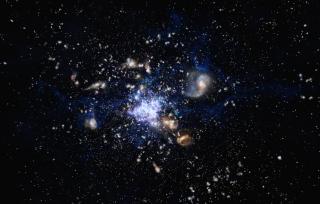Bibcode
Shimakawa, Rhythm; Pérez-Martínez, J. M.; Dannerbauer, Helmut; Koyama, Yusei; Kodama, Tadayuki; Pérez-González, Pablo G.; D'Eugenio, Chiara; Zhang, Yuheng; Naufal, Abdurrahman; Daikuhara, Kazuki
Bibliographical reference
The Astrophysical Journal
Advertised on:
12
2024
Journal
Citations
9
Refereed citations
7
Description
We report the initial result of our Paβ narrowband imaging on a protocluster with the JWST Near Infrared Camera (NIRCam). As NIRCam enables deep narrowband imaging of rest-frame near-infrared lines at z > 1, we target one of the most studied protoclusters, the Spiderweb protocluster at z = 2.16, in which previous studies have confirmed more than a hundred member galaxies. The NIRCam F405N narrowband filter covers in the Paβ line the protocluster redshift given by known protocluster members, allowing for the search for new member candidates. The weight-corrected color–magnitude diagram obtained 57 sources showing narrowband excesses, 41 of which satisfy further color selection criteria for limiting the sample to Paβ emitter candidates at z ∼ 2.16, and 24 of them do not have Hα emitter counterparts. The Paβ emitter candidates appear to follow the spatial distribution of known protocluster members; however, follow-up spectroscopic confirmation is required. Only 17 out of 58 known Hα-emitting cluster members are selected as Paβ emitters in the current data, albeit the rest fall out of the narrowband selection owing to their small Paβ equivalent widths. We derive the Paβ luminosity function in the Spiderweb protocluster, showing a normalization density of at a characteristic Paβ luminosity of . Furthermore, we examine the possibility of detecting faint line emitters visible only in the narrowband image but find no promising candidates.
Related projects

Molecular Gas and Dust in Galaxies Across Cosmic Time
Two of the most fundamental questions in astrophysics are the conversion of molecular gas into stars and how this physical process is a function of environments on all scales, ranging from planetary systems, stellar clusters, galaxies to galaxy clusters. The main goal of this internal project is to get insight into the formation and evolution of
Helmut
Dannerbauer